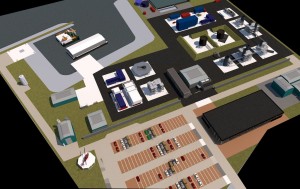New Falck Training Centre
 Falck is due to open a new training centre on the Maasvlakte in 2018. It will become an international, high-profile safety-knowledge centre for public and industrial fire brigades, the offshore, maritime sector and wind industry. The first steps have been taken 24 January 2017, with Falck and the Port of Rotterdam Authority entering into a contract under which the site is issued to Falck. The company is set to leave its current site on the Beerweg when its lease with the Port of Rotterdam Authority ends in the spring of 2018. This situation gives the opportunity to develop a brand new safety centre, a decision for which the company has the full cooperation of the Port of Rotterdam Authority (the organisation responsible for managing and operating the port area).
Falck is due to open a new training centre on the Maasvlakte in 2018. It will become an international, high-profile safety-knowledge centre for public and industrial fire brigades, the offshore, maritime sector and wind industry. The first steps have been taken 24 January 2017, with Falck and the Port of Rotterdam Authority entering into a contract under which the site is issued to Falck. The company is set to leave its current site on the Beerweg when its lease with the Port of Rotterdam Authority ends in the spring of 2018. This situation gives the opportunity to develop a brand new safety centre, a decision for which the company has the full cooperation of the Port of Rotterdam Authority (the organisation responsible for managing and operating the port area).
Back in 1985, a large training centre for the fire brigade, industry, offshore and the maritime industry was set up just several kilometres from the company’s current site, the result of a partnership between the Port of Rotterdam Authority, Smit Internationale and the Nederlandse Veiligheidsdienst. The most important objective of the safety centre, which was operated under the names Risc and Nutec at that time, was to create a safe residential and working environment at the port of Rotterdam. The contract signed today marks the continuation of the original partnership. The new site is situated several hundred metres to the east of the existing training centre.
Occupation of the new site in the spring of 2018 will involve far more than just the relocation of activities, as reflected in the two principles underlying development of the new site: the achievement of an interactive and realistic experience and the bringing together of knowledge and practice. The new centre, which will cover an area more than one hectare bigger than the current site, will be designed and built in accordance with the very latest standards for technology, the environment, occupational hygiene and safety and training technologies (virtual reality environments for incident control and crisis management, for example). The new site will also feature a field lab, for research and practical experiments. The functional wishes and needs of both national and international clients are the guiding principle on which the design for the training facilities is based.






